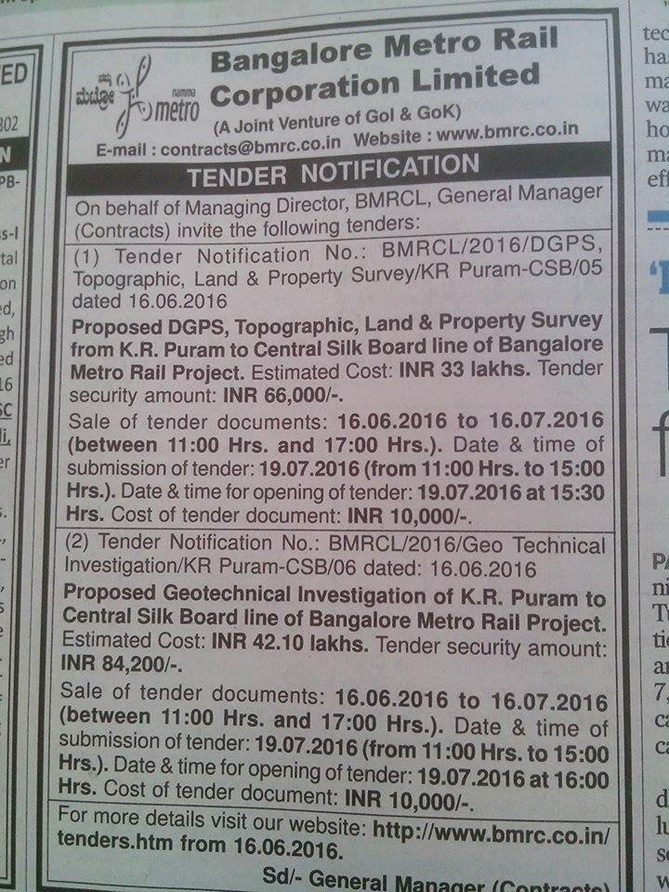BMRCL Invites Geotechnical Bids for Central Silk Board – KR Puram Line
Hat tip to TMRG reader Ajith Kumar.
The new 18 km Central Silk Board – KR Puram line that was envisioned to be built in Phase 3 as part of a longer line just got a small but significant push late last week with the Bangalore Metro Rail Corporation (BMRCL) inviting bids for two survey & investigation related contracts! The Detailed Project Report (DPR) for this line has not been finalized by RITES yet, but is expected to be ready in the coming months. That along with the data captured through these investigative contracts will help the BMRCL present a detailed report to the Karnataka Government’s cabinet for their approval.
Bids invited for:
• Proposed DGPS, Topographic, Land & Property Survey from K R Puram to Central Silk Board of Bangalore Metro Rail Project – Link
Contract: BMRCL/ 2016/ DGPS, Topographic, Land & Property Survey/ KR Puram – CSB /05
Date & time to submit bids: July 19 (11 am -3 pm)
• Proposed Geotechnical investigation of KR Puram to Central Silk board line of Bangalore Metro Rail Project – Link
Contract: BMRCL/2016/Geo Technical Investigation/K.R.Puram-CSB/06
Date & time to submit bids: July 19 (11 am -3 pm)

Tender notification published in the papers on May 16 – Courtesy: Ajith Kumar
The Central Silk Board – KR Puram line was a surprise announcement at the Invest Karnataka summit held in early February and has the full backing of Bengaluru Development Minister K G George. Since then, BMRCL officials have looked into various “innovative” funding models to build this line in addition to the 72 km Phase 2 project, and its High Power Committee (HPC) recently decided to send a detailed proposal to the state cabinet with these new methods of financing.
The line’s alignment is fairly straightforward along the Outer Ring Road and will pass through/by Silk Board Junction, Agara, HSR Layout, Iblur, Green Glen Layout, Bellandur, Kadubeesanahalli, Marathahalli, Anand Nagar, Doddanekundi, Mahadevapura to reach Krishnarajapuram (KR Puram). At Silk Board Junction, the line will allow users to switch to the upcoming 18.80 km RV Road – Bommasandra line while users at KR Puram will be able to switch to the Purple Line’s upcoming station which is also being built in Phase 2 as part of the 15.50 km Byappanahalli – Whitefield extension.
I cannot stress enough how crucial & beneficial this line would be for residents and businesses along its catchment area. In order to be financially viable, I expect it to be entirely elevated. Its development depends on how quickly the line’s DPR is presented before the cabinet, how much time they take to approve and finally how quickly the BMRCL can tender out contracts for Phase 2’s construction. Note that the BMRCL is yet to invite construction bids for roughly 79% of the Phase 2 project and has a huge backlog to process.
If this line were to be built in addition to Phase 2, here’s a glimpse of how it might look like in Brown color. You can choose to zoom in/out to view specific areas:
If the line were to be hypothetically approved this year, then taking pre-construction activities (such tying up funds through partnerships, acquiring land, hiring a Detailed Design Consultant etc.) into account, I expect the BMRCL to only be able to invite construction bids in 2019 with actual work starting in 2020.
For more updates, check out the Bangalore section of The Metro Rail Guy!
– TMRG




this is a good move. hopefully will get done by 2025
When one looks at kind of traffic jams along
ORR, this line is absolutely & urgently needed. Hope next 7 yrs this becomes reality
I am assuming they will hopefully learn slowly from the mistakes and cut the time by half atleast. I am optimistic about a 2025 finish for our entire network even though people will be skeptical about that. 🙂
I hope they do it in 2 sub phases, i.e. Central silk board to Marathalli, And Marathalli to KR Puram. Not personally vouching for any , but it will definetly help people + BMRCL enjoy benefits(By generating ticket revenue as and when the network gets built)
I will be surprised if this gets completed by 2025, almost half of the IT Corridor guys would have retired by then all 2000 batch engineers.
This metro line is for our children who will be ready to work in the outer ring road. At least let next generation enjoy metro, if not grand children.
True, metro projects take long time as they are very costly with multiple funding sources (including through loan agencies), have to be built within already built up city areas, involves huge land acquisitions with opposition from some quarters, disruption etc.
Unfortunately, all Indian cities (except Delhi) have to completely fund the venture themselves or through state govts as central support and assistance is poor, even if the city needs metro very badly, like Bangalore does.
And long-gestation projects like metro, power plants, ports etc are not for one generation. They are for the decades ahead. So, if we cannot use it, let us hope the next generation can make good use of it.
Hi, central govt’s approvals haven’t been timely in some cases (eg. Chennai’s 9 km extn) but the assistance is definitely not poor. Their share accounts for only 20-25% of all EPC metro projects and funds are disbursed over time if/when a project is approved. I cannot recollect when funds haven’t been allocated leading to delays. Initially all projects start off on state funds and then the proceeds from loans & CG funds start kicking in.
This ‘preferential treatment’ argument is something I’ve often heard from Mumbaikers and read in many “investigative reports”. But with other tier 2 cities (especially Lucknow, Nagpur & Ahmedabad) already building far bigger systems, it is slowly dawning upon them that the problem lies within themselves – with their incompetent MMRDA, with their crazy land-use/CRZ laws, with their silly activists, and their rubbish politics.
I’m not sure about Mumbai, but yes, there is a lot of delay in expanding their metro, which I feel is mainly because the city is too dense with no land to spare and route plans changing frequently because of this.
However, I know about Bangalore. CG’s funds for ph-1 was held up and accounted for part of the delay in awarding tunnelling tenders, apart from DMRC’s botched & delayed DPRs for both phases. CG’s approval for BMRC’s ph-2 took two years & was given just before state assembly elections with a motive to influence election results. It did, because congress did get voted back to power!
Also, see this article:
“In the 2016-2017 budget, the total allocation for the Urban Development Ministry headed by M Venkaiah Naidu was Rs 21,100 crores. Of this, more than 20 percent was allocated to a single project in Delhi – namely the Delhi Metro. This amount is more than what was allocated for metro projects in Mumbai, Bengaluru, Chennai, Kochi, Lucknow and Nagpur all combined. The real share of Delhi in the budget allocation is actually closer to 30 percent, when one considers the various other headings under which the ministry allocated more money to Delhi, including a separate National Capital Region sub-allocation. No such separate allocation for a specific urban area exists in the Urban Development Ministry budget and the amounts given to NCR through such methods are much higher than what is allocated to the next few mega-cities combined.”
Read more at:
http://www.firstpost.com/india/when-money-for-other-states-is-given-to-delhi-it-resembles-the-imperial-seat-of-an-empire-2832392.html
Couple things:
1) Approvals in India are always politically motivated but once approved, the allocation has always been appropriate to the amount required & when required. This has never been a delaying factor.
2) BM Phase 1’s contracts were held up because (1) the bids were higher than expected & (2) the UG section required design rework + revalidation due to an improper DPR. The 1st issue led to the division of packages & lengthy negotiations to bring their contract values down. The entire tendering process (from inviting tenders to opening bids to awarding contract) is always done under the guidance and approval of the ODA lender – be it it in Delhi, Lucknow or Nagpur. In BM’s case, JICA was calling the shots and the delay had absolutely nothing to do with CG funds.
3) Let’s stop bringing up DMRC’s name in all comments. They were not the lead or only partner in the DPR creation process or General Consultant roles. They were booted out in 2011 while the new PH2 DPR was approved in 2012. It’s now 2016 & we know where the Phase 2 project stands in terms of minor approvals that should have been secured way back or in terms of inviting bids. The problem lies within.
4) That report makes no mention that Mumbai’s projects have been held up or that new projects at a nascent stage like Lucknow/Nagpur/Bangalore PH2 do not require major CG funds at this time.
1) True that approvals are always politically motivated, but Bangalore having commenced early, BMRC did find the going tough as there were no precedents other than Delhi metro. As per news reports of that time, I remember that CG funds did play a role in the delay after the re-tendering, as did approvals from railways for right of way and inspections /certification by CMRS.
These issues have subsequently been streamlined post these events & may not be a worry to other metros now, though they had been initially and had added to BMRC’s delays for completing ph-1.
2) Noted.
3) I beg to differ. DMRC did DPRs for both phases for BMRC and were prime consultants till Nov-2011. DPR for ph-2 was delayed by 24 months since they had accorded higher priority to preparing DPR for Delhi metro’s ph-3 though the request from BMRC had been made much earlier (DMRC’s ph-3 was top priority for CWG then). However, the DPR being faulty, it had to be redone entirely and this took time. It wasn’t approval/s that have delayed things since they already had CG’s approval.
Meanwhile, TBMs broke down and this necessitated an even more deeper study of soil conditions for ph-2’s tunnelling and preparation of plan-Bs in case of eventualities in terms of land requirement for recovery shafts etc as the tunnels pass through very congested areas. They have finally completed it and are now coming up with land acquisition notifications.
I believe they did right as it is better to delay and take the right steps rather than go ahead unprepared.
4) The report describes clearly as to how much the urban ministry supports Delhi metro in comparison with other metros under construction.
BTW BMRC had developed a funding model that is described in a presentation, see link below:
http://finmin.nic.in/the_ministry/dept_eco_affairs/MI/infra_workshop/Mr_Vasanth_Rao_Bangalore_Metro.pdf
Hi,
1) I’ll say it again – the tendering process has nothing to do with CG funds. It’s entirely dependent on state funds & loan proceeds, right from the notice to the contract award. Tendering activity for projects involving loans is always influenced by the ODA lender – please see my posts on Lucknow, Ahmedabad or Nagpur’s metro projects in which contracts are awarded or tendering begins right after loan deals are signed. If the CG funds had a role, then the Lucknow or Noida Metro projects wouldn’t have gotten to where they are.
Railways & CMRS approvals are a big pain everywhere, including Delhi (see example). Nothing unique to Bangalore.
3) BM Phase 1 DPR Creators: RITES & DMRC (link to tunnel talk article)
BM Phase 1 Consultants: RITES + Oriental + Parsons Brinkerhoff + Systra (link to BMRC’s info page & Project Director’s profile)
As for Phase 2, the part about requiring deeper & more frequent borewells to study what lies beneath is quite true, but only pertains to the underground section which represents about 14 km out of 72 kms planned in Phase 2. What explains the delay in inviting bids for the elevated corridors like the one to BIEC or Whitefield? Or what explains the delay in securing approvals for smaller (but painful) tasks like tree cutting approvals on the already contracted out sections? The problem lies entirely within.
Btw, this specific comment sub-thread has reached its limit. You can post a new reply if you choose to.
This junction has huge potential from ridership perspective. They need not wait till completion of the whole stretch from KR Puram to Silk Board. Even a part of functioning metro could fetch good money. Silkboard to Marathahalli is one traffic hell. If Metro attacks that part first, half the problem would be solved both for commuter and BMRCL.
But any way, it is too early to comment.
The situation in ORR is very grim. Metro is the need of the hour. Glad that bmrcl is showing seriousness instead of waiting for phase-3.
DPR for phase-2 had to be approved again as cost estimates were incorrect in the first. It was approved finally in 2014, not 2012.
http://moud.gov.in/sites/upload_files/moud/files/Sanction%20Lr-BMRC-Ph-2-21-2-14.pdf
Honesty, this section and the airport line have to be expedited and completed along with Phase 2. I don’t see why they have to push these lines further into Phase 3.
When completed this would be the most busy metro route of B’luru metro.So should be financially viable whether elevated or underground.No?
Hi, besides being more expensive to construct, underground operations entail a higher maintenance cost for running tunnel ventilation & station air-conditioning systems. Not only would the loan amount be more, but the ability to service that loan’s debt would be tougher as opposed to servicing a loan for an elevated line.
I haven’t done any math on this, but don’t you think that once you go underground, these differences in cost can be off-set with the significantly more real estate to lease out underground? Like you can have a mini-mall underground and lease it out – with assured foot-falls.
Utmost Importance.
This Line passing through Marathahalli is very important and it can serve several purpose.
1) Traffic reduction: If this is not in place, in few years the traffic would be so high that, companies may opt out of Bangalore
2) I hope this can also be like a overhead walkway ( similar to subway ) from both sides. This would enable people to cross the road and avoid accidents and traffic blocks.
3) Control Pollution. Most of this section sees huge IT companies and this would enable people to use metro as it be cheaper and convenient.
I congratulate the Minsters and Decision makers on getting on this line on priority.
Residents of East Bangalore
Very true. Companies are opting out of Bangalore. Let’s wait till 2025 for all this to complete.
I don’t think Govt understands the urgency in completing any metro line.
http://m.deccanherald.com/articles.php?name=http%3A%2F%2Fwww.deccanherald.com%2Fcontent%2F554940%2Fchange-phase-2-give-metro.html
This info looks quite interesting!! Lets hope this happens
This line is going to be fast tracked.
http://economictimes.indiatimes.com/industry/transportation/shipping-/-transport/metro-along-
it-corridor-in-bengaluru-on-fast-track/articleshow/52983836.cms
As a short term the state govt if at all they care introduce some suburban trains on the tracks to hosur…like BYPL to Hosur and YNK to Hosur to provide some relief to commuters. Imagine at 10pm also it takes a hour to cover this stretch. Sad to see our neighboring states demanding so much from central and getting it done while our good for nothing netas cannot even get trains rolling on existing tracks.
This is a metro line which is needed right now. Hope they can manage the traffic well. With many bridges on ORR along with insane traffic, going to be very difficult.
May be toll on this section of ORR will help fund the metro rail project.